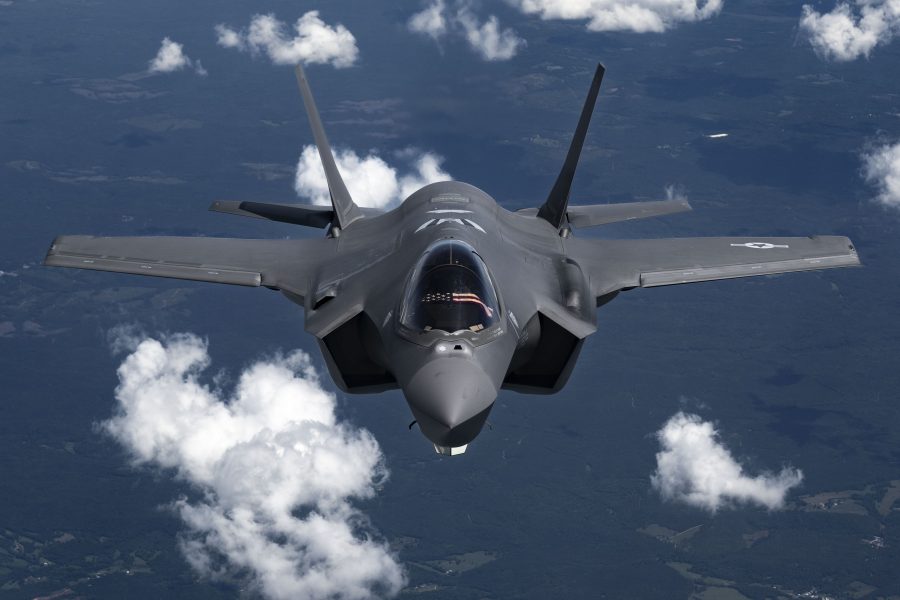The House Appropriations Committee released its version of the fiscal 2025 defense appropriations bill on June 4, an $833 billion bill that would increase funding for the F-35 and block the service from retiring the U-2 spy plane and some F-15s.
The proposed legislation sets up a conflict with the House Armed Services Committee, which used its version of the National Defense Authorization Act to propose slashing F-35 procurement by 10-20 jets from the services’ request of 68 jets and use the funds to boost the program’s test and evaluation infrastructure. House appropriators want to fund procurement for 76 F-35s for all services in 2025.
Specifically for the Air Force, appropriators want to add two F-35As to the request of 42, for a total of 44 F-35As.
Type Pentagon Request HASC NDAA* HAC Appropriations F-35A 42 36 44 F-35B 13 11 13 F-35C 13 11 19 TOTAL 68 58 76
The HAC’s spending will would also only fund six new F-35 test aircraft, while the HASC NDAA funded nine.
The NDAA authorizes funding and sets policy for the Pentagon, while the appropriations bill actually provides the money.
Elsewhere in the appropriations bill, lawmakers included provisions that would block the Air Force from being able to “divest or prepare to divest” the U-2 spy plane, as the service has said it wants to do in 2026.
Similarly, the Air Force would not be allowed to divest or prepare to divest “any F-15 aircraft unless the Secretary of Defense certifies … that such aircraft will be replaced in a manner that maintains the current total aircraft assigned at a given unit and the readiness of such unit.”
The Air Force recently revealed its F-15C/D fleet only has a 33 percent mission capable rate, due mainly to the type being past its planned retirement and suffering from structural fatigue, flight restrictions and obsolescent parts. The service plans to retire 37 F-15s in 2025, 11 C/D models and 17 E models.
Appropriators did leave the Air Force’s request for its other major fighter procurement program, the F-15EX, alone, to the tune of $1.8 billion for 18 F-15EX fighters for $1.8 billion. They also went along with the Air Force’s request for 15 KC-46A tankers, providing $2.7 billion for them, and funded eight MH-139 Gray Wolf missile field support helicopters at a level of $294 million.
Lawmakers also met the Air Force request of $3.3 billion for the Next-Generation Air Dominance program—which includes the autonomous Collaborative Combat Aircraft.
Some programs may see potential increases if the committee gets its way. Lawmakers added $400 million to “accelerate” the E-7 Wedgetail airborne command and control program, which will succeed the E-3 AWACS. They also tacked on two HH-60W rescue helicopters for the Air Force and two C-130Js for the Air National Guard, even though the Air Force did not ask for either aircraft. It provided $120 million for the HH-60s and $263.4 million for the two C-130Js.
A pay increase of 4.5 percent was funded for all service members, and the appropriators provided $2.5 billion to boost junior enlisted pay by 15 percent, matching the HASC version of the NDAA.
Defense-wide, the HAC provided just $163.5 billion for procurement, a drop of $1.4 billion below the Biden administration’s request and $6.7 billion below the fiscal 2024 enacted level. The HAC also cut the Pentagon’s operations and maintenance request by $2 billion, to $294.3 billion, which was still $7.1 billion above the 2024 enacted level.
In defense-wide research, development, test and evaluation, the HAC provided $145.9 billion, or $2.7 billion more than requested, but $2.4 billion below the fiscal ‘24 enacted amount. That includes $2.1 billion to continue development of the F-35 for all the services, and $2.7 billion for continuing development of the B-21 bomber.
The HAC appropriated $3.4 billion for continued development of the Air Force’s Sentinel intercontinental ballistic missile, indicating its support for the program, which is in a Nunn-McCurdy breach, having exceeded its baseline cost estimate by 37 percent.
The Air Force’s Hypersonic Attack Cruise missile was funded at $492.7 million, and the Defense Advanced Research Projects Agency and the Joint Hypersonic Transition Office would get $99.97 million.
The appropriators provided “over $900 million” for the Pentagon’s Defense Innovation Unit “and select defense-wide innovation efforts to deliver capabilities from nontraditional sources, attract America’s best companies and talent, and increase flexibility for DIU Fielding in exchange for greater transparency with Congress.” The DIU funding included $220 million to address combatant commander priorities and $45 million for facilities needed to develop and test some capabilities in secret.
The full House Appropriations Committee takes up the defense bill the week of June 10.


